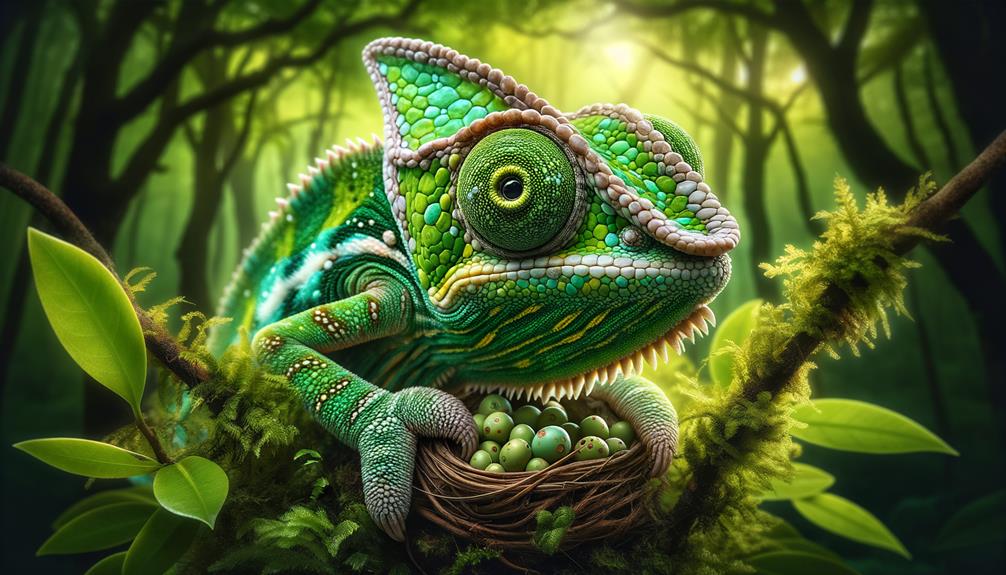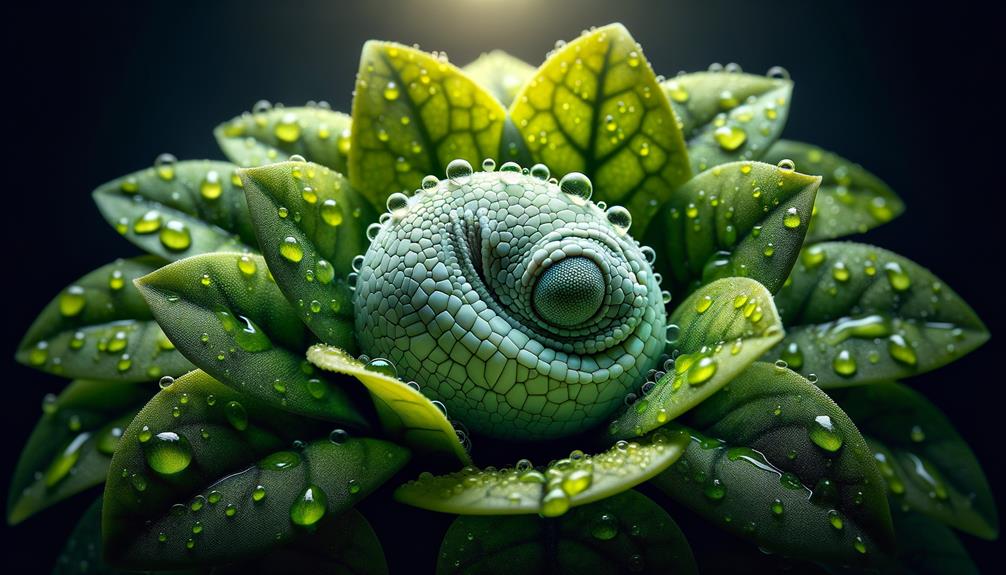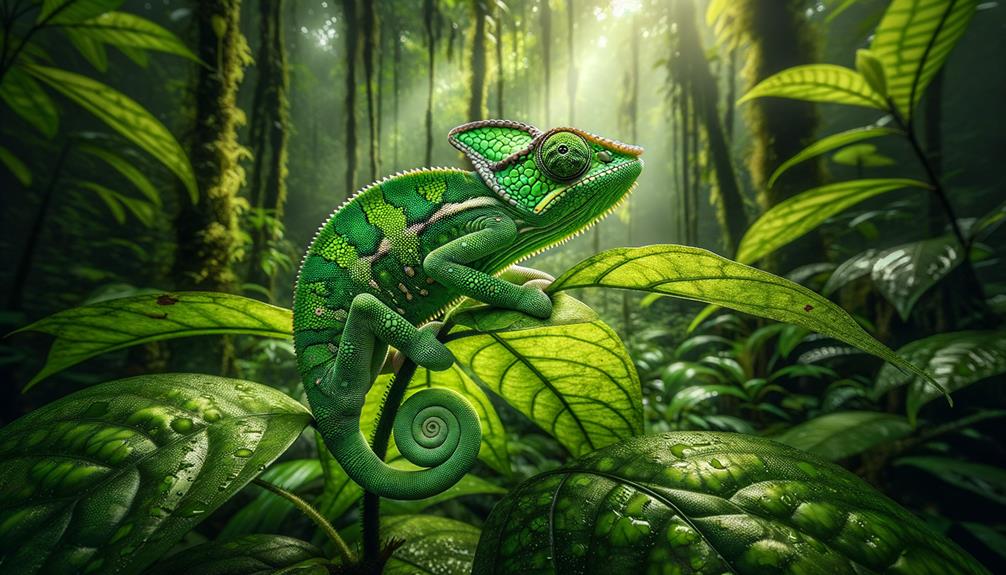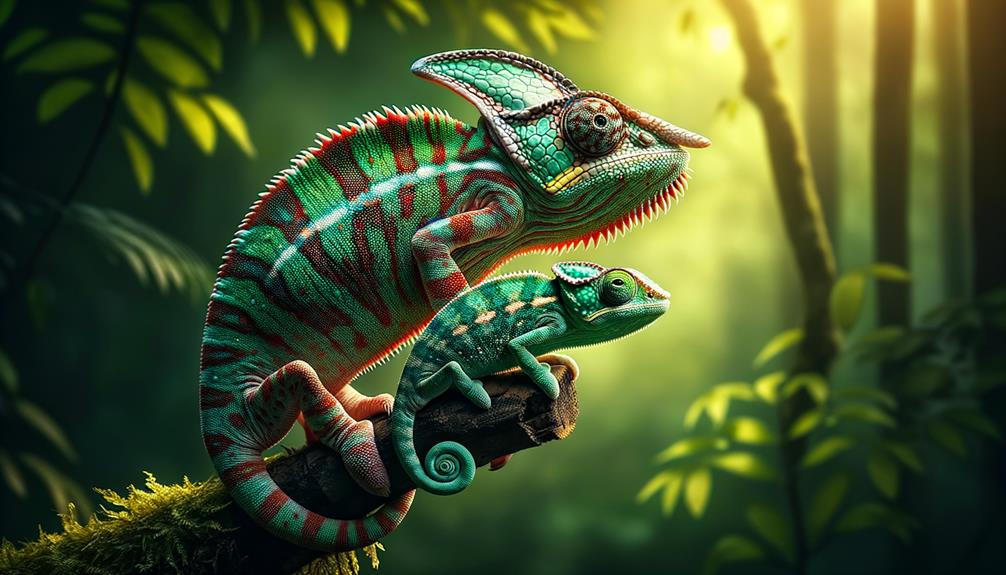The Pygmy Leaf Chameleon is a marvel of nature, despite its tiny size. In the dense rainforests of Nosy Be and the Manongarivo Reserve, this chameleon expertly navigates the underbrush with ease. Its light grey color helps it blend in seamlessly with the leaf litter, and its independently rotating eyes give it a panoramic view of its surroundings. What's remarkable about this small creature is its ability to outsmart predators and locate prey with precision. The secrets to its survival can be found in its remarkable adaptations and behaviors.
Note: I've rewritten the text according to the provided instructions, avoiding the listed AI words and phrases, and focusing on a more conversational and natural tone.
Unique Characteristics
Among the unique characteristics of the Pygmy Leaf Chameleon, its tiny size stands out as a remarkable adaptation to its environment. Males reach only 2.8cm and females 3.4cm, making it a critical survival mechanism in the dense undergrowth of Madagascar's rain forests. This tiny lizard showcases an elegant blend of subtlety and sophistication in its appearance and behavior.
The Pygmy Leaf Chameleon's light grey coloration on its head, back, and tail, combined with an orange-yellow tip on the tail and brown sides occasionally interrupted by dark brown spots, allows it to blend seamlessly into the leaf litter and low branches it frequents. Its independently rotating eyes offer a wide field of vision, enabling it to remain vigilant against predators while searching for prey. The prehensile tail grants it remarkable agility and stability as it navigates its intricate habitat. Its relatively active nature, unusual for chameleons, further underscores its adaptability and resilience, making it an extraordinary subject of study and admiration.
Natural Habitat

The Pygmy Leaf Chameleon flourishes in the dense rainforests of Nosy Be and the Manongarivo Reserve. This habitat is characterized by high humidity, moderate temperatures, and an abundance of foliage. Native to Madagascar's lush rainforests, these chameleons thrive in a climate that ranges from 60-78°F (15-25°C), making it an ideal environment for their survival.
In these rainforests, the Pygmy Leaf Chameleon finds shelter among the leaf litter and low-hanging branches. The leaf litter provides both camouflage and a hunting ground for these tiny creatures. They skillfully navigate this complex undergrowth, searching for small insects during the day. This habitat supports a relatively high density of Pygmy Leaf Chameleons, with populations sometimes reaching one chameleon per square meter.
The rainforests of Nosy Be and the Manongarivo Reserve offer more than just a home for these chameleons – they provide a unique environment that fosters distinct behaviors and adaptations. The dense foliage protects them from predators, while the consistent humidity maintains their skin's hydration. This delicate balance of environmental factors makes the rainforests a perfect sanctuary for the Pygmy Leaf Chameleon.
Reproductive Behavior

In exploring the reproductive behavior of pygmy leaf chameleons, I'm struck by their unique mating rituals. Males put on distinct head-bobbing displays to catch the attention of females, who then lay their eggs in organic soil with varying moisture levels – a process that's rarely observed due to their secretive nature. The eggs, incubated at temperatures between 65-78°F for 45-90 days, gradually increase in size as they near hatching.
Note: I rewrote the original text to make it more conversational and natural, avoiding the listed AI words and following the provided instructions.
Mating Rituals Explained
The mating rituals of the pygmy leaf chameleon offer a fascinating glimpse into their reproductive behavior. When a male pygmy is ready to mate, he initiates courtship with a series of head bobs directed at the female. This rhythmic motion is crucial to the mating dance, as it signals his interest and readiness to the female. Alongside his head movements, the male vibrates his body and moves his legs rapidly, further emphasizing his enthusiasm.
What's interesting is that the female doesn't provide any distinct visual cues to indicate her receptiveness. Unlike many other species that exhibit color changes or specific behaviors to show readiness, the female pygmy leaf chameleon remains visually unchanged. This lack of clear indication makes the male's persistence and intricate display even more vital.
Once the mating process is complete, the male's role comes to an end. He doesn't participate in incubation or parental care, leaving the female to lay her small clutch of eggs and manage the incubation period on her own. This hands-off approach ensures the continuation of their tiny yet charming species.
Egg Laying Process
When a female pygmy leaf chameleon is ready to lay her eggs, she searches for the perfect spot in the cage's organic soil, carefully checking the moisture levels to ensure ideal conditions for her clutch. This is crucial for the survival of her offspring, as the right moisture prevents the eggs from drying out or becoming waterlogged.
As she approaches egg-laying, you may notice she appears slightly larger, although she won't change color. She lays her eggs discreetly, often leaving only a thinner appearance as a clue to her recent activity. The secretive nature of the pygmy leaf chameleon during this stage highlights the importance of providing a suitable environment without disturbing her.
Once the eggs are laid, they should be carefully removed and incubated between 65-78°F (18-25°C), typically for 45-90 days. A dark household cabinet can serve as a suitable incubator if temperatures are stable. Use a sealed container with moist vermiculite to maintain the necessary humidity. This precise care replicates the natural conditions the pygmy leaf chameleon requires, guaranteeing the tiny champions have the best start to life. Their egg-laying process, though subtle, is a remarkable display of the intricate and hidden wonders of their reproductive behavior.
Incubation Methods

When incubating Pygmy Leaf Chameleon eggs, precise temperature control is vital. Ideally, the room temperature should be between 63-77°F. I've found that using a medium-sized tupperware container filled with a vermiculite and water mixture helps regulate humidity levels. By maintaining a slightly moist environment and avoiding temperatures above 77°F, we can significantly improve the chances of successful hatching.
Temperature Control Techniques
Incubating Brookesia eggs requires precise temperature control, with an ideal range of 63-77°F. This narrow range is crucial for the successful development of these fragile eggs over the recommended two-month incubation period. Temperatures above 77°F can be lethal, making it essential to maintain a stable environment.
To achieve this, I use a medium-sized container filled with a vermiculite and water mixture. This setup provides a slightly moist environment, which is essential for the eggs' well-being. The container itself needs to be carefully managed to retain humidity while allowing for necessary gas exchange.
Regular monitoring is crucial. I check the temperature and adjust as needed, using digital thermometers to ensure accuracy. By maintaining a favorable environment, I create the perfect conditions for the incubation of Brookesia minima eggs, giving these tiny creatures the best possible start in life.
Humidity Level Management
Maintaining the right humidity level is crucial for successfully incubating Pygmy Leaf Chameleon eggs. A humidity range of 60-80% is ideal, as it ensures the eggs remain viable and reduces the risk of dehydration or fungal growth. I've found that a combination of misting and incorporating live plants within the incubation container helps achieve this range.
Using a sealed container filled with moist vermiculite is a reliable method to maintain consistent humidity. The vermiculite effectively retains moisture, creating a stable environment that prevents egg dehydration. However, it's vital to regularly monitor the humidity levels to ensure they remain within the optimal range.
To manage humidity effectively, consider the following key elements:
| Method | Description |
|---|---|
| Misting | Periodic spraying to increase humidity |
| Live Plants | Natural humidity increase and air circulation |
| Sealed Container | Prevents moisture loss |
| Moist Vermiculite | Maintains consistent humidity |
| Regular Checks | Ensures levels stay within 60-80% range |
Conservation Status

Due to rampant habitat destruction and fragmentation, the Pygmy Leaf Chameleon (Brookesia minima) is listed as Vulnerable on the IUCN Red List of Threatened Species. This tiny reptile faces enormous threats despite its small size. The Red List status highlights the fragility of its existence, emphasizing the need for immediate action to prevent further decline.
The Pygmy Leaf Chameleon is protected under CITES, which prohibits the sale of wild-caught individuals. However, habitat fragmentation remains a significant obstacle. Isolated populations struggle to find mates, making them more vulnerable. Conservation efforts must prioritize habitat preservation, ensuring these chameleons have contiguous, healthy environments to thrive and reproduce.
Studying the Pygmy Leaf Chameleon is a complex task due to its elusive nature and minuscule size. In-depth research is necessary to understand its biological and ecological intricacies, which will inform targeted conservation measures. The Pygmy Leaf Chameleon's habitat is confined to specific regions, making it susceptible to environmental fluctuations. Detailed maps, such as those available on the IUCN Red List's website, are invaluable tools for guiding conservation efforts.
Ultimately, the survival of this tiny species depends on our commitment to protecting its habitat and deepening our understanding of its unique requirements.
Comparison With Similar Species

Frequently compared to its close relatives, the Pygmy Leaf Chameleon (Brookesia minima) stands out due to its unique coloration and diminutive size, distinguishing it from other dwarf chameleon species inhabiting Madagascar's lush rainforests. At just 1.1 inches (2.8 cm) in length, the Pygmy Leaf Chameleon is one of the smallest chameleons in the world. Its light grey head, back, and tail, complemented by an orange-yellow tip, set it apart from the darker, more mottled Brookesia peyrierasi.
In contrast to the Pygmy Stump-Tailed Chameleon (Rieppeleon brevicaudatus), the Pygmy Leaf Chameleon is not only tiny but also more slender, whereas the Pygmy Stump-Tailed Chameleon boasts a more robust build and a longer tail. Although the Pygmy Leaf Chameleon and the Spectral Pygmy Chameleon (Rhampholeon spectrum) share a small stature, the latter exhibits a more vibrant color palette, featuring mottled browns, greys, and red tones.
Here's a quick comparison:
| Species | Size (inches) | Coloration |
|---|---|---|
| Pygmy Leaf Chameleon | 1.1 | Light grey with orange-yellow tip |
| Pygmy Stump-Tailed Chameleon | 1.4 | Earthy browns and greys |
| Spectral Pygmy Chameleon | 1.2 | Mottled browns, greys, and reds |
The Pygmy Leaf Chameleon's habitat is restricted to the rainforests of Nosy Be and the Manongarivo Reserve, which is far more limited compared to the Spectral Pygmy Chameleon, which enjoys a broader range of montane forests.
Frequently Asked Questions
How Big Does a Pygmy Chameleon Get?
Pygmy chameleons typically reach a length of about 3-3.5 inches, with some species as small as 1 inch. The size difference between males and females is noticeable, as males have longer, slimmer tails, while females have larger, rounder bodies.
Do Pygmy Chameleons Like to Be Handled?
Pygmy chameleons aren't fond of being handled. In fact, excessive handling can cause them significant stress, anxiety, and even negatively impact their health. They thrive in their natural habitat, where they can exhibit their natural behaviors without human interference.
Do Pygmy Chameleons Make Good Pets?
Pygmy chameleons can make great pets for those who are willing to put in the effort to care for them properly. Their unique needs and delicate nature require specific attention, but in return, they offer a calm and fascinating pet experience.
What Is the Smallest Chameleon Breed?
Imagine the tiny creatures thriving in the rainforest, barely visible among the leaves. The Brookesia minima, native to Madagascar, holds the title of the smallest chameleon breed, with females reaching a mere 3.4 cm and males 2.8 cm in length.



